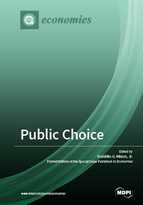Public Choice
A special issue of Economies (ISSN 2227-7099).
Deadline for manuscript submissions: closed (15 January 2019) | Viewed by 66581
Special Issue Editor
Interests: public choice; labor economics; industrial organization; sports economics
Special Issues, Collections and Topics in MDPI journals
Special Issue Information
Dear Colleagues,
Interest in politics and the political process—topics that economists consider to be the purview of the sub-field of study known as public choice—appears to be as high as ever. This Special Issue of Economies aims to provide a collection of high-quality studies covering many of the varied topics traditionally investigated in the growing field of public choice economics. These include, but are not limited to, voting/voters, elections, constitutions, legislatures, executives, judiciaries, bureaucracy, special interest groups, parliamentary procedures, government failure, rent seeking, public finance, and international organizations. We welcome original papers relating to these and other aspects of public choice.
Prof. Dr. Franklin G. Mixon, Jr.
Guest Editor
Manuscript Submission Information
Manuscripts should be submitted online at www.mdpi.com by registering and logging in to this website. Once you are registered, click here to go to the submission form. Manuscripts can be submitted until the deadline. All submissions that pass pre-check are peer-reviewed. Accepted papers will be published continuously in the journal (as soon as accepted) and will be listed together on the special issue website. Research articles, review articles as well as short communications are invited. For planned papers, a title and short abstract (about 100 words) can be sent to the Editorial Office for announcement on this website.
Submitted manuscripts should not have been published previously, nor be under consideration for publication elsewhere (except conference proceedings papers). All manuscripts are thoroughly refereed through a single-blind peer-review process. A guide for authors and other relevant information for submission of manuscripts is available on the Instructions for Authors page. Economies is an international peer-reviewed open access monthly journal published by MDPI.
Please visit the Instructions for Authors page before submitting a manuscript. Please refer to https://www.mdpi.com/journal/economies/apc for Article Processing Charge (APC). Submitted papers should be well formatted and use good English. Authors may use MDPI's English editing service prior to publication or during author revisions.






